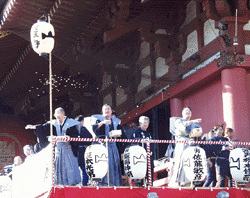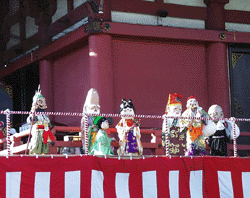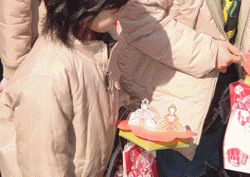
|
The word "festival"("matsuri" in Japanese) usually remind us stalls in thestreet, portable shrines("mikoshi" in Japanese) and so on. Would you like to know what the word "festival" means originally? |

|
The archaic Japanese word "matsurafu"written in Manyoshu,
the oldest anthology in Japan,is equivalent for the word "festival".
The word "matsurafu" means inviting our deities,making offerings for them
and praying them for keeping evels and diseases away from us and bringing us happiness.
One Japanese festival usually has three stages.
They are the grand festival,the ceremony of the festival and the "shinkosai" festival
in which our deities parade riding on the portable shrines,"mikoshi".
We Japanese call all of them in one word "matsuri".
One of the essential articles for the Japanese festival is the portable shrine,"mikoshi".
Originally "mikoshi" is the vehicle for our deities to parade.
And,each of the deities has own "mikoshi",for example in the "Sanja"(means three shrines) Festival
three "mikoshis" are used for the first shrine,the second shrine and the third shrine.
By the way,these three "mikoshis" survived through many fires,for example,
the fire in the Great Kanto Earthquake,but at last they were burned in the fire of the war damage.
Fortunately the plans of the three "mikoshis" escaped the war damage
and the "mikoshis" were restored after the war and are still now used.
Those "mikoshis" are now usually kept in the temporary house made
by the steeplejacks by using logs and bamboos in the traditional way.
This traditional way of building was taught from generation to generation
and still now the steeplejacks are taught about it from more experienced men naturally.
The festivals consist of three factors,which are the sponsors,the participants and the viewers.
And,of course,when these three factors work as one,the festival becomes the wonderful event.
In Asakusa very popular streets like the Metro Street and the Orange Street play the good supporting roles
to make up the festivals as the wonderful events.
And,many large paper lanterns hung on poles ("takaharichochin" in Japanese) decorated around the Sensoji Temple
play the same role.
Many people feel the beautiful scene of the lanterns lighted at night like a dream.
The Sanja Festival in Asakusa is such a delightful event and is crowded with about 3 million "galleries" every year.
Applause and cheering from both the local people in Asakusa
and many "galleries" from other areas arouse the excitement in the Sanja Festival every time.
We think the excitement in the Sanja Festival has great importance when we compare
with many other areas in Tokyo where people are reluctant to live and their catch phrase "My hometown Tokyo" sounds ironically.
Jan・Feb・Mar・Apr・May・Jun
- Events in Asakusa-
Jul・Aug・Sep・Oct・Nov・Dec
Note: The schedule may change for items that are "planned".
| January, 2024("Mutsuki" in old Japanese) | ||
| 1st | Paying The First Visit To The Shrine Of The Year | |
| Pilgrimage to the shrines / temples on New Year's Day. | ||
| 7th | The Festival For The Japanese Radish | |
| Held in Matsuchiyamashoten People make offerings various kinds of food to Matsuchiyamashoten,the guardian deity for Buddha. People pray for the safety of their families and for prosperity of their business in this Buddist service. After that the attendants boil Japanese radishes and eat them putting vinegared miso on them. |
||
| 8th | Tondo Yaki | |
| This ceremony is held in the Torigoe Shrine. People burn many remains of the New Year's goods. It is traditionally said that we can spend the year in good health by exposing ourselves to this fire. 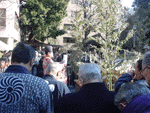 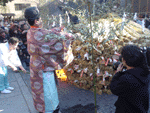 It was done modesty and the fire was Powerful full mark. TV shooting was taking place. |
||
| June, 2024(Minatsuki) | ||
| 7th-9th | Torigoe's night festival | |
| 29th-30th | The Beginning of the Mountaineering Season of Mt.Fuji | |
| This ceremony is held connected with the festival held in the Fuji Sengen Shrine at the foot of Mt.Fuji. People call this ceremony "O Fuji San". |
||
Note: The schedule may change for items that are "planned".




